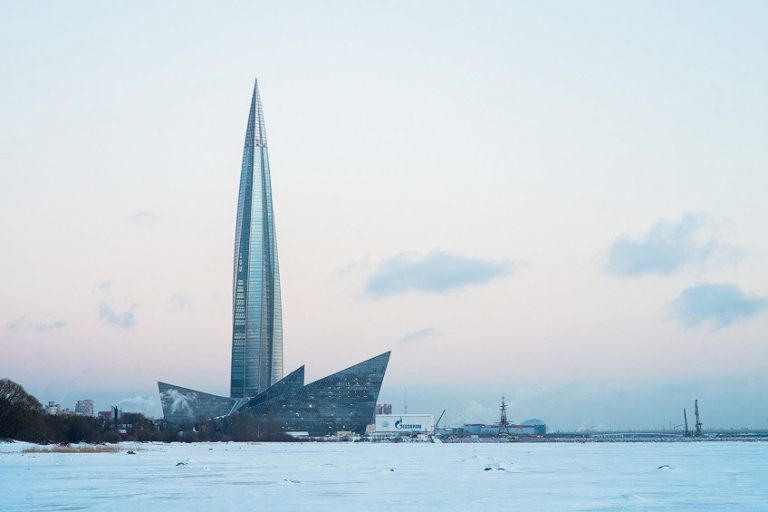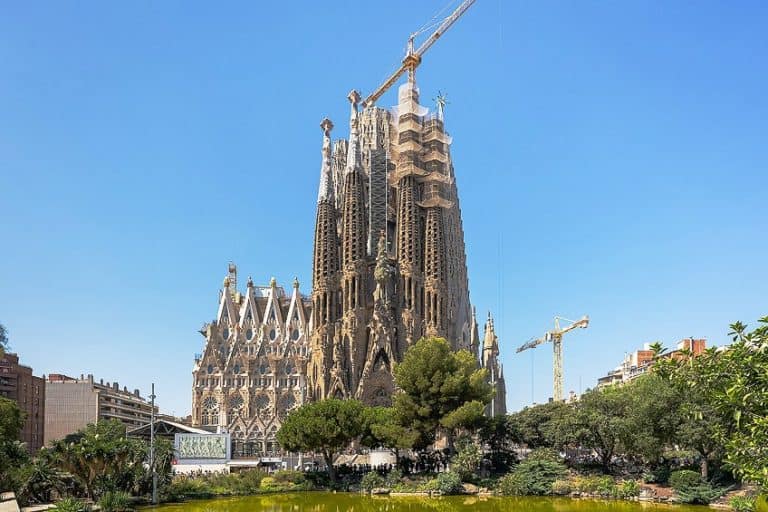Kaaba in Mecca – The Religious Significance of Kaaba
What is the Kaaba in Mecca and what is inside the Kaaba? The Kaaba in Mecca is a highly-revered edifice located in the heart of Islam’s most renowned mosque, known as the Masjid al-Haram. Inside the Kaaba, there are gold and silver lamps suspended from the ceiling, which is held up by three pillars. Today, we will cover all of the historical and scientific facts about the Kaaba in Mecca, and answer questions like, “where is the Kaaba located?”.
Table of Contents
What Is the Kaaba in Mecca?
| Architect | Ibrahim (1996 BCE) |
| Date Completed | 683 CE (rebuilt) |
| Materials | Stone, marble, and limestone |
| Function | Mosque |
| Location | Masjid al-Haram, Hejaz, Saudi Arabia |
| Height (meters) | 13 |
This square-shaped structure is gracefully covered in a silk and cotton veil and is known as the most important spiritual shrine among Muslims. The Kaaba in Mecca is the last stop for people on the holy pilgrimages of Umrah and Hajj. Furthermore, the Kaaba’s history may be traced all the way back to pre-Islamic Mecca. In the Islamic faith, the Kaaba in Mecca is regarded as the holiest location on Earth. The renowned Kaaba is mentioned multiple times in the Islamic holy book, the Quran, and it is referred to as mankind’s first temple of worship in various passages.
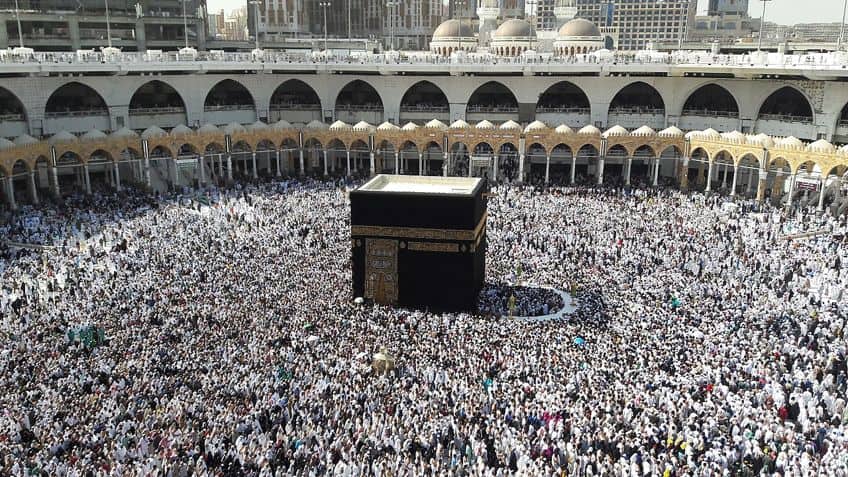
The Physical Structure of the Kaaba in Mecca
After the Kaaba in Mecca was built, Allah commanded Ismail’s descendants to go on the Hajj pilgrimage annually. In addition, the area around the temple was converted into a sanctuary where bloodshed and violence were prohibited. The Kaaba was originally built as a plain unroofed rectangular building.
In 608 CE, the Quraysh tribe, which ruled pre-Islamic Mecca, reconstructed the Kaaba in Mecca with masonry and wood blocks.
The Kaaba’s Location
Masjid al-Haram is a mosque in Saudi Arabia’s Mecca Province. It is a pilgrimage location for the Hajj, as well as the primary phase for the Umrah, the minor pilgrimage that may be attended at any point in the year. The Hajj pilgrimage constitutes one of Islam’s five pillars, and it is obligatory for all physically fit Muslims who are able to afford it. Both of these pilgrimages involve circumambulating the Kaaba inside the mosque. Other prominent landmarks around the Great Mosque are the Zamzam Well, the Black Stone, Maqam Ibrahim, and the hills of Marwa and Safa.
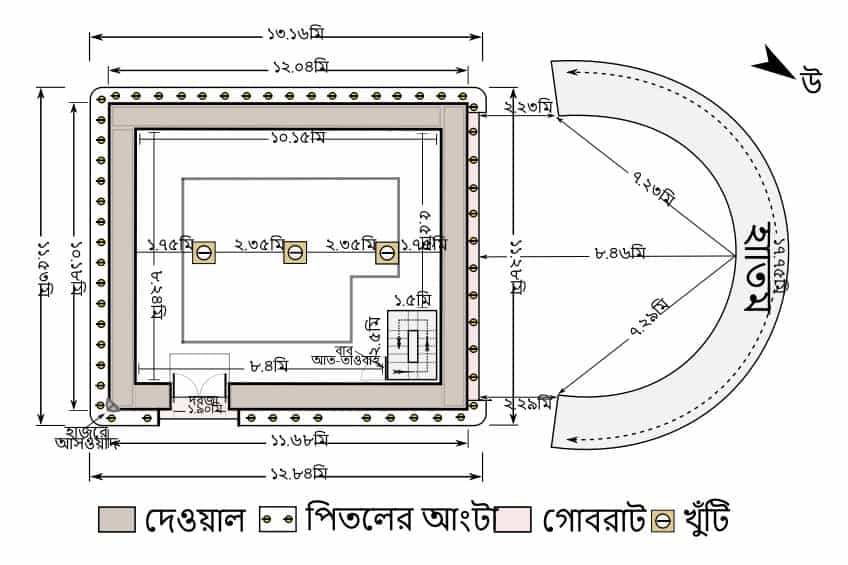
It is the world’s biggest mosque and has undergone extensive modifications and extensions throughout the years. It has passed through the hands of several sultans, caliphs, and monarchs until falling under the sovereignty of the King of Saudi Arabia, who is known as the Custodian of the Two Holy Mosques. There has been considerable concern that the mosque’s and Mecca’s expansion efforts are endangering early Islamic heritage. Many historic structures, some dating back over a thousand years, have been razed to make way for the expansion of the holy site.
Dimensions of the Kaaba
The Kaaba in Mecca is a stone edifice in the shape of a cuboid. It stands around 15 meters tall and has sides that are 12 meters by 10.5 meters. The 13 meters x 9 meters inside walls are tiled white marble halfway to the top, with darker accents along the floor.
The internal floor is around 2 meters above the ground where tawaf takes place.
Description of the Black Stone
The Black Stone of Mecca is an Islamic artifact of reverence laid into the Kaaba’s eastern wall and most likely originating from the Arabs’ pre-Islamic faith. It is presently made up of three bigger pieces and a few fragments, encircled by a stone ring and held bound together by a silver band. Based on popular Islamic belief, the stone was handed to biblical Adam on his fall from paradise and was initially white before gathering the transgressions of the thousands of pilgrims who kissed and caressed it, turning it black.

It was taken away in 930 CE by extremists of the Qarmatian sect and kept for ransom for almost 20 years. There are several legends about the existence and placement of the stone within the Kaaba. Another widespread version claims that Prophet Ibraham and Ismael went looking for various sorts of stones for the construction of the Kaaba when they stumbled across the Black Stone. After they realized its value, they put it in the corner of the building.
The Hateem Area
The Hateem is a low wall that was formerly part of the Kaaba in Mecca. This comprises a semi-circular wall opposite, yet not attached to, the hatim, the northwestern wall of the building. It’s made of white marble. Because the space between the hatim and the square structure was once connected to the Kaaba itself, it is not accessed during the Tawaf. Pilgrims are not permitted to walk in the area between the Kaaba and this wall. A water outflow channels water from the Kaaba’s roof all the way down to the Hateem area.
The Quraysh were the first to build this. According to Aisha, when she questioned Muhammad if the Hateem was a part of the Kaaba in Mecca, he answered that it was.
When she inquired as to why it hadn’t been incorporated into the Kaaba’s walls, he said, “Because your citizens did not have sufficient funds to do so”. Abdul Muttalib, Muhammad’s grandfather, liked being near the Kaaba in Mecca and would occasionally have a couch laid for him in this spot. When he was resting there one night, a shadowy figure appeared to him in a vision and told him where he was likely to find the Zamzam Well, which had been hidden since the Jurhum tribe’s time.
Kaaba’s Door and Roof
The Quraysh decided to rebuild the Kaaba because it had degraded over time as a consequence of continuous floods in Makkah and had suffered considerable water damage. In addition, because the Kaaba was regarded as a very sacred location that no one dared to damage, individuals would deposit their treasures inside it. However, there have been occasions where robbers have looted the riches that had been deposited within. They made certain structural alterations to the building to discourage robbers. They eliminated one door, raised the other entrance off the ground, and added a roof. The Kaaba in Mecca actually has two roofs, one inner and one exterior.

The additional one was made to reinforce the framework even further. The distance between the two roofs is slightly more than a meter. The Kaaba’s door has been acclaimed as one of the most iconic Islamic structures since its construction. The Kaaba door has seen significant alterations over history, from being built of wood to silver, steel, and gold. It is now constructed of pure gold and etched with Holy Quran passages. Despite the fact that we only see one entrance now, a storm that rocked Hajj in 2018 revealed that the Holy Kaaba in Mecca used to have two doors.
Inside the Kaaba
The ceiling is held in place by three wooden columns, each of which is about 1,350 years old. Every one of these inner columns has a pillar that is used for suspending gifts in the structure. The three pillars were built by Abdullah bin Zubair, a well-known Muslim figure and one of the Quran’s compilers. There is an enclosed stairway that leads to a hatch, which is an enclosed rectangular structure without any windows and just a door that leads to the ceiling. The door is covered with a silk curtain with silver and golden engravings.
The Kaaba’s interior features a marble floor and colored marble panels on the walls. Red silk curtains with white embroidered writing adorn the inside of the Kaaba as well as the ceiling.
There are eight stones within that have Arabic writing on them in several kinds of scripts. Yet another panel was placed on the building’s eastern wall between the Gate of Repentance and the Kaaba’s door by Fahd of Saudi Arabia, the custodian of the two holy mosques, bringing the total number of marble documents to 10, all of which are engraved on white marble. The floor has particular marks that represent the exact place where Prophet Muhammad is believed to have prayed when he visited the Kaaba.
Pre-Islamic History
Historian Patricia Crone has questioned whether Mecca was an important ancient commerce station, but other academics, such as Glen Bowersock, believe it was. Crone eventually abandoned several of her theories. She claims that skin hides, leather items, Hijazi woolens, clarified butter, and camels were important in the Meccan trade. She believes that the majority of these items were meant for the Roman army, which was known to require massive quantities of leather and skins for its equipment. Prior to the emergence of the Islamic faith, the Kaaba in Mecca was a sacred location for the Arabian Peninsula’s numerous Bedouin tribes.

Bedouins would conduct a pilgrimage to Mecca every lunar year. Leaving tribal feuds aside, they would venerate their gods at the Kaaba and trade in the city. Inside the Kaaba, several paintings and sculptures were on display. A statue of Hubal, as well as sculptures of other pagan deities, have been found in or around this location. Apart from the artwork of pagan idols that adorned the walls and were demolished at Muhammad’s request following his takeover of Mecca, there were also images of angels, Ibrahim clutching divination darts, and Isa and his mother Maryam, which Muhammad preserved. The Kaaba was found to contain unspecified ornaments and coins, in addition to a pair of ram’s horns. Based on Islamic beliefs, the set of the ram’s horns was from the ram sacrificed by Ibrahim as a substitute for his son Ismail.
History of the Kaaba in Mecca
Although its exact history is unknown, many think Ibrahim constructed the Kaaba in Mecca, which started as a plain rectangular construction without a roof. The Quraysh, Mecca’s reigning clan, reconstructed the structure in stone and wood in about 608 CE. The Kaaba became the focal point for pilgrimage and worship when Muhammad arrived in Mecca in 629 CE. The Kaaba was established as the direction towards which Muslims have to direct their daily prayers, as well as the location of the hajj. In the year of his death, 632 CE, Muhammad made his final trip to Mecca, establishing pilgrimage traditions and the significance of the Kaaba.
The Kaaba and its surrounding areas have been altered several times since Islam’s inception. To accommodate the growing number of pilgrims, Caliph Umar extended the space surrounding the Kaaba.
The colonnades that surround the open courtyard where the Kaaba sits were erected during the reign of Caliph Uthman. In 683 CE, the Kaaba was destroyed by fire during the civil war between Ibn Zubayr, who held Mecca, and the caliph Abd al-Malik. According to legend, Al-Hajar al-Aswad split into three parts, which Ibn Zubayr later reconstructed with silver.
He reconstructed the Kaaba in stone and wood, according to the specifications established by Ibrahim, and paved the area surrounding the Kaaba. After retaking Mecca in 692 CE, Abd al-Malik destroyed the Kaaba and rebuilt it in the Quraysh style. The mosque around the Kaaba was enlarged and remodeled multiple times by the early Abbasid caliphs. From 1269 until 1517, the Egyptian Mamluks ruled the Hijaz, which included Mecca. Sultan Qaitbay constructed a religious school on one side of the mosque. Following Mamluk’s sovereignty, Mecca was taken over by the Ottoman Sultans.

Sultan Süleyman I rebuilt the Kaaba’s roof in 1553, ordering that the hardwood ceiling be decorated with golden calligraphy and floral motifs. After being damaged by a flood in 1611, Sultan Murad IV reconstructed the Kaaba in 1629. The freshly laid foundation was created in accordance with Abraham’s design, and the upper structure was constructed with massive granite blocks sitting on a marble base. The Kaaba now lies at the heart of the Masjid al-Haram, the Great Mosque, which has expanded over the ages to occupy around 40 acres.
Significance of Kaaba in Islam
The yearly journey to the Kaaba in Mecca is referred to as Hajj, and it represents one of Islam’s most important religious observances. All physically fit Muslims who are capable of paying for the journey must perform Hajj at least once in their lives. It is held from the 8th to the 13th of the month. Pilgrims enter a state of ceremonial consecration known as Ihram before beginning the journey. This requires males to wear specific clothes and women to dress modestly. Ihram represents a condition of equality, purity, and separation from worldly issues. Pilgrims journey to Mecca, which is their final destination.
Pilgrims arrive at Mecca and carry out the Tawaf, which entails circumnavigating the Kaaba seven times anticlockwise. It represents Muslims’ solidarity and devotion to Allah.
Following Tawaf, pilgrims conduct Sa’i, which consists of walking seven times between the hills of Marwa and Safa. This gesture is meant to commemorate Hajar, Prophet Ibrahim’s wife, searching for water in the desert. The ninth day of Dhu al-Hijjah is the most important day of Hajj. Pilgrims congregate on the plain of Arafat for prayer. This day is thought to represent the Day of Judgement and repentance and prayers are offered. Pilgrims travel to Muzdalifah after sundown on the Day of Arafah, where they stay the night in the open air, praying. The next day, they gather stones for the pillar-stoning rite.

Pilgrims flock to Mina in order to perform the pillar-stoning ceremony, which symbolizes the denial of temptation and evil. They hurl rocks at three pillars symbolizing Satan. Pilgrims then offer an animal sacrifice on the 10th of Dhu al-Hijjah, known as Eid al-Adha, to commemorate Prophet Ibrahim’s readiness to sacrifice his own son. The meat is provided to those in need. As a mark of completion of the primary ceremonies, pilgrims shave or cut their hair. They execute Tawaf al-Ifadah, another circling of the Kaaba, then Sa’i once more. The Muslim pilgrims perform their final Tawaf to the Kaaba before departing Mecca.
The Significance of the Tawaf
Tawaf is one of the most essential Islamic pilgrimage rites, and it is required on both the Umrah and Hajj. As we mentioned earlier, the pilgrims walk around the Kaaba seven times in an anticlockwise fashion, the first three at a rapid speed on the outer section of the Mataaf and the final four times at a leisurely pace closer to the Kaaba. The circling is said to reflect the oneness of Muslim believers in their adoration of the One God, as they move in unison around the Kaaba in Mecca while praying to God.
Wudu (ablution) is required while doing tawaf since it is seen as a form of worship.
Tawaf starts with the Black Stone in the Kaaba’s corner. Muslims are urged to touch or kiss it if possible, yet, this is generally impossible due to the massive crowds. They are also required to call out the Takbir and Basmala after each revolution. Hajj travelers are typically instructed to do tawaf at least twice: once during the Hajj and once before departing Mecca.
The Significance of the Qibla
The qibla is the Islamic term for the direction towards the Kaaba in Mecca’s Sacred Mosque, which Muslims rely on in a variety of religious circumstances, most notably the direction of prayer for the salah. The Kaaba is considered a sacred place in the Islamic faith, and its usage as the qibla was commanded by Allah in various chapters of the Quran conveyed to Muhammad. Before this revelation, Muhammad and his followers in Medina prayed facing Jerusalem.

Most mosques have a mihrab that shows the qibla direction. The qibla additionally represents the direction in which animals faced during dhabihah; the preferred direction for doing dua; the direction to steer clear of while urinating or spitting; in addition to the direction in which the recently deceased are aligned when burial. Muslims employed ancient methods to find the qibla before the introduction of astronomy in the Islamic world. These techniques consisted of facing the direction that the followers of Muhammad had used when they were in the same location, utilizing the rising and setting positions of celestial objects, using the wind’s direction, or facing directly south, which was Muhammad’s qibla in Medina.
Early Islamic astronomy was based on its Greek and Indian equivalents, particularly Ptolemy’s writings, and by the mid-9th century, Muslim astronomers had established ways to compute the probable directions of the qibla. In the late 9th and 10th centuries, Islamic astronomers devised methods that are equal to the present formula for determining the exact direction of the qibla.
At first, this “qibla of the astronomers” was utilized alongside other historically established qiblas, resulting in a great deal of variation in medieval Muslim cities.
Furthermore, until the 18th and 19th centuries, reliable geographic data was not accessible for astronomical methods to provide an exact conclusion, leading to further qibla variability. Throughout the Islamic world, historical mosques with varying qiblas can still be seen. The spaceflight of Sheikh Muszaphar Shukor, a devout Muslim, to the International Space Station in 2007 sparked debate about the qibla direction from low Earth orbit, leading Malaysia’s Islamic authority to suggest establishing the qibla “depending on what is possible” for the astronaut.
Cleaning of the Kaaba
The structure is opened for the ceremonial “Cleaning of the Sacred Kaaba” twice a year. The event is held on the 1st of Sha’baan, the Islamic calendar’s eighth month, approximately 30 days before the commencement of Ramadan, and on the 15th of Muharram, the first month of the Islamic calendar. The Ban Shaybah tribe holds the keys to the Kaaba, an honor conferred upon them by Muhammad. On the occasion of the cleaning ritual, individuals from the tribe greet guests inside the Kaaba.
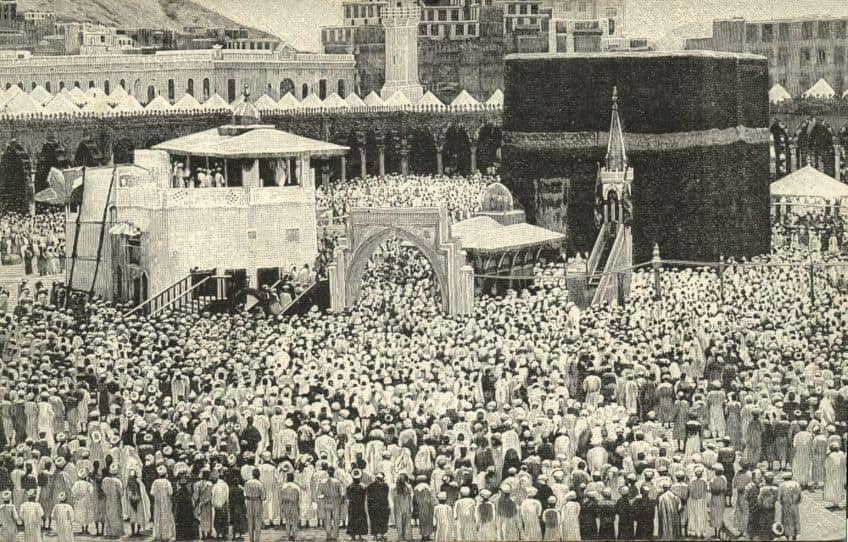
The Makkah Province Governor and other dignitaries scrub the inside of the Kaaba in Mecca using towels dipped in Zamzam water perfumed with Oud. The washing preparations begin a day before the scheduled day, with the combining of Zamzam water with many luxuriant scents, including oud, Tayef rose, and musk. Zamzam water with a rose scent is sprayed on the floor and brushed with palm leaves. Typically, the entire operation takes around two hours.
Scientific Facts About Kaaba
According to some scholars, the corners of the Kaaba correspond with the cardinal directions. During the winter solstice, the southeastern corner lines up with the sunrise, whereas the northwestern corner of the Kaaba in Mecca aligns with the sunset. It is crucial to remember, however, that these alignments are susceptible to measurement precision and the Kaaba’s historical direction. The Kaaba is made of a variety of materials, including marble, granite, and limestone.
The adoption of these long-lasting materials has helped the Kaaba to survive the test of time while remaining structurally sound.
Can Tourists Visit Kaaba?
If you have ever wondered whether you can visit Mecca as a tourist, the answer is no, unless you’re Muslim. This is because the Saudi government only allows Muslims to enter Mecca. Documentation will be verified upon admission and anybody who fails to provide proof of Muslim identity will be denied entry to Kaaba in Mecca. Non-Muslims who seek to enter Kaaba face deportation and a potential fine. This restriction applies whether you arrive in the city by air, car, bus, or rail.

There are facilities to help those with physical disabilities attend the Hajj, such as specially built wheelchairs that are capable of handling the terrain and fitting the pilgrimage’s ceremonial practices. As a result, even people who are unable to walk or have other infirmities may complete the Hajj.
As we have learned, the Kaaba in Mecca has been regarded as the final destination of an essential pilgrimage for any Muslim who is physically sound enough to attend it. Every Muslim desires to perform the Hajj at least once throughout their lives. Hajj is regarded as the fifth pillar of Islam and is reserved for those who are able to perform it. The Kaaba, which means “cube” in Arabic, stands 15 meters tall and is veiled in black silk. The mound on which the Kaaba stands was a shrine even before the pre-Islamic era. The Kaaba was said to be erected by Prophet Ibrahim and his son Ismail in Islamic history.
Frequently Asked Questions
What Is Inside the Kaaba?
Most people would be surprised to find out that the Kaaba is largely empty. Inside the Kaaba one can find three pillars that hold up the roof of the structure. There are also various golden and silver lamps that hang down from the roof.
Where Is the Kaaba Located?
The Kaaba is regarded as one of the Islamic faith’s most important destinations, especially as the final stop of several important pilgrimages. It is located in Saudi Arabia in the Mecca province. However, one needs to be Muslim if one wants to enter Mecca itself. The location itself has a centuries-old history that dates back even further than the pre-Islamic era. It is believed that the renowned Islamic prophet Ibrahim built the building along with his son Ismail. It is ranked as the biggest mosque in the world and was rebuilt several times.
Justin van Huyssteen is a freelance writer, novelist, and academic originally from Cape Town, South Africa. At present, he has a bachelor’s degree in English and literary theory and an honor’s degree in literary theory. He is currently working towards his master’s degree in literary theory with a focus on animal studies, critical theory, and semiotics within literature. As a novelist and freelancer, he often writes under the pen name L.C. Lupus.
Justin’s preferred literary movements include modern and postmodern literature with literary fiction and genre fiction like sci-fi, post-apocalyptic, and horror being of particular interest. His academia extends to his interest in prose and narratology. He enjoys analyzing a variety of mediums through a literary lens, such as graphic novels, film, and video games.
Justin is working for artincontext.org as an author and content writer since 2022. He is responsible for all blog posts about architecture, literature and poetry.
Learn more about Justin van Huyssteen and the Art in Context Team.
Cite this Article
Justin, van Huyssteen, “Kaaba in Mecca – The Religious Significance of Kaaba.” Art in Context. July 31, 2023. URL: https://artincontext.org/kaaba-in-mecca/
van Huyssteen, J. (2023, 31 July). Kaaba in Mecca – The Religious Significance of Kaaba. Art in Context. https://artincontext.org/kaaba-in-mecca/
van Huyssteen, Justin. “Kaaba in Mecca – The Religious Significance of Kaaba.” Art in Context, July 31, 2023. https://artincontext.org/kaaba-in-mecca/.




